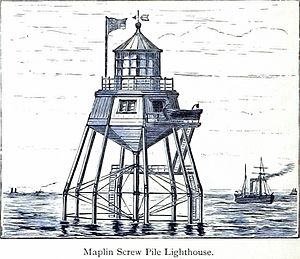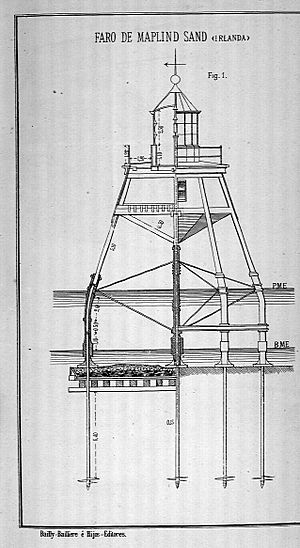Maplin Sands facts for kids
The Maplin Sands are large areas of mudflats found on the northern side of the River Thames estuary. They are located off Foulness Island, near Southend-on-Sea in Essex, England. These sands are very important for nature. They are part of the Essex Estuaries Special Area of Conservation. This is because they have a large group of dwarf eelgrass, which is a special plant, and many animals that live there.
To the northeast, the Maplin Sands connect to the Foulness Sands. The Whitaker Channel borders these sands to the north. This channel is where the River Crouch flows into the sea. To the south, you'll find the Swin Channel.
Contents
History of Maplin Sands
Maplin Sands has a long and interesting history. People have used this area for different purposes over many years.
The Ancient Broomway Track
Maplin Sands is crossed by a very old path called The Broomway. This track has been used for centuries. It's a unique and sometimes dangerous route across the mudflats.
The Maplin Lighthouse Story
In 1838, a special lighthouse was built on the sands. It was a screw-pile lighthouse, which means it stood on large screws drilled into the seabed. This was the first screw-pile lighthouse ever designed!
The lighthouse was built by Messrs. Mitchell and Sons. It was suggested by James Walker of Trinity House, a group that looks after lighthouses. Even though construction started first, another lighthouse, the Wyre Light, was finished earlier. This was because the Wyre Light was built much faster.
Over time, strong tides in the Thames caused problems. The water washed away the sand around the lighthouse's base. Sadly, the lighthouse became unstable and was completely swept away in 1932.
Ship Speed Trials
In the late 1800s, two important shipbuilding companies, John I. Thornycroft & Company and Yarrow Shipbuilders, used Maplin Sands. They tested the speed of their new destroyers here. They would measure how fast the ships could go over a specific distance.
The water in this area is quite shallow. This shallow water could make the ships seem to go faster than they actually did. It could add up to one knot (a measure of speed) to their recorded speed. When the the Admiralty (the government department in charge of the navy) found out, they made a new rule. All future ship trials had to be done in deep water.
Plans for a New Airport
In 1973, there were big plans for Maplin Sands. The government wanted to build a third airport for London here. It was going to be called the Thames Estuary Airport. The project was very ambitious. It would have included a deep-water harbour for large container ships. There would also be a fast train link to London. A whole new town was planned to house the thousands of workers needed for the airport.
However, these plans were stopped in 1974. This happened because of economic problems, including a big oil crisis in 1973. The cost of the project became too high.
Military Training Area
Today, and for a long time, Maplin Sands has been a military testing ground. It belongs to the Ministry of Defence. Foulness Island next to it is also used for military purposes.
Nature and Wildlife
Maplin Sands is a very important place for nature. It is part of the Essex Estuaries Special Area of Conservation. This means it's protected because of its valuable wildlife.
Home to Dwarf Eelgrass
One of the most special things about Maplin Sands is its large colony of dwarf eelgrass (Zostera noltei). This is a type of seagrass that grows in shallow, muddy areas. It's an important plant because it provides food and shelter for many different animals.
Animal Communities
Many animals live in and around the dwarf eelgrass beds. These include various types of fish, crabs, and other small sea creatures. The mudflats also attract many birds, especially wading birds, who come to feed on the worms and shellfish found in the mud. Protecting Maplin Sands helps these unique plant and animal communities to thrive.




